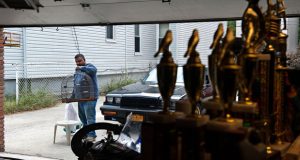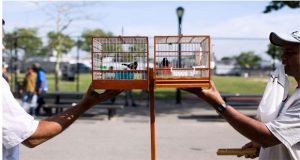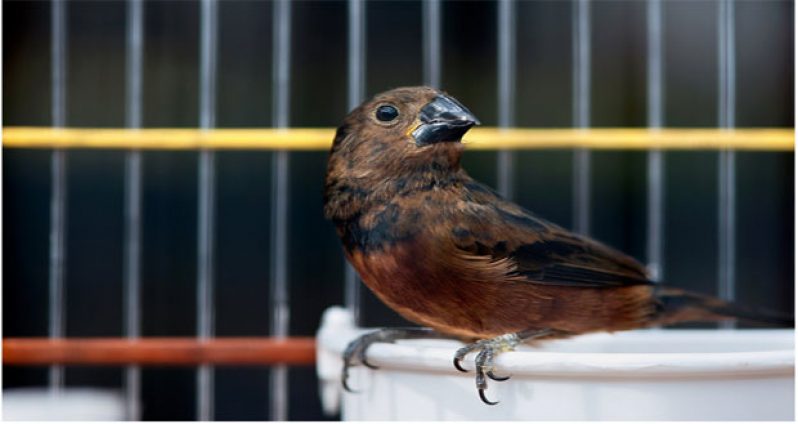(New York Times) Ray Harinarain cut the lusty Hellcat engine of his Dodge Challenger and gently lifted his birdcage from the front seat.Mr. Harinarain, a heating and air-conditioner repairman from Brooklyn, joined a procession of middle-aged men in fedoras and flat caps, cradling wood poles and cages the size of large shoe boxes, streaming into a pocket-size park in Richmond Hill, Queens, on a recent Sunday morning. The cages were blanketed in white coverlets, some trimmed with lace. Inside each one was a delicate songbird: a chestnut-bellied seed finch native to the northern parts of South America and the Caribbean.

Sundays are race days, though the events are not really races but speed-singing contests. Two cages each containing a male finch, whose fierce calls are triggered by an instinctive desire to woo females and defend turf, are hung on a pole about an inch apart. The birds are judged on the number of songs they sing. The first to reach 50 wins.
Ostensibly, it’s a battle of the birds. But there is just as much grandstanding by their male handlers. Many hail from Guyana, with others from Trinidad, Suriname and Brazil, places where amateurs and professionals line grassy roadsides and town squares, vying for trophies, cash prizes and prestige at tournaments or impromptu matches. Owning a champion, which can be worth as much as a car, also has cachet. Even well-known soccer players have acquired them as status symbols.
But as the finches migrated with their human wards to North American cities, where it is more common to see someone walking a cat than a bird, the hobby has attracted unwanted attention from federal law enforcement. Although it is much gentler than cockfighting, the sport has a seedy side.
Customs agents at John F. Kennedy International Airport began uncovering birds zipped into suitcase linings, sometimes stuffed in toilet paper rolls, or tucked inside socks, pantyhose, or specially tailored pants. The discoveries prompted agents at the United StatesFish and Wildlife Service’s Office of Law Enforcement to start what would become an eight-year investigation, nicknamed Operation G-Bird, that focused on the illegal smuggling of these prized competitors.
The chestnut-bellied seed finch (Oryzoborus angolensis) is not considered an endangered species. But transporting the birds without proper paperwork and under inhumane conditions violates, among other laws, the Lacey Act, which combats illegal trafficking in fauna and flora. The Guyanese government began issuing permits for the legal export of birds in recent years, but importing birds on the books to the United States is an expensive and time-consuming process that requires approval from multiple federal agencies, hiring licensed bird brokers and paying government fees. A mandatory 30-day quarantine is also stressful on birds and can undermine their training.

For decades, the epicenter of New York’s racing scene has been Phil “Scooter” Rizzuto Park, which the men still refer to by its old name, Smokey Oval. In between the handball court and the baseball diamond, the men erect a patchwork of wood and metal cages perched on car tops, benches, hanging on telephone poles or wooden stakes planted in the ground. In recent years, the mood there has become tense with a pervasive fear that undercover agents and informants lurk with binoculars and hidden cameras.
Mr Harinarain, known as “Bush,” wears a gold, flat-braided chain with a bird charm. He presides as an unofficial spokesman for the birdmen, at times to the chagrin of his peers who are reluctant to expose their passion to criticism. After emigrating from Berbice, Guyana, in 1987, he began tending to the birds belonging to the elder statesmen in the park. When he could afford his own finches, he began organizing competitions, eventually succeeding the older generation.
“I control the birds now,” he said.
Federal agents have visited Mr. Harinarain’s home in Cypress Hills, where he lives with his wife and 43 birds that chirp from almost every corner, including the bathroom. The more valuable ones are monitored with webcams streamed to his iPhone. And each week, he spends about $100 and about an hour every other day inspecting their feathers and toes, scooping 10 varieties of seed into their trays, dropping liquid vitamins into feeding tubes and filling plastic cups with water so they can “take a shower.”
His garage is crammed with bird trophies and dozens of dangling empty cages. He was among the first in New York City to breed the finches, called “towa towa” in Guyana. But it was a tedious and difficult process, so now he imports them from Brazil, which has an organized industry of breeders. From a filing cabinet, he pulled out the birth certificate of one of the birds, a blue sheet of paper with a diagram resembling a family tree. Like racehorses, the male songbirds are bred for their pedigrees, he explained.

“Most of the guys don’t want to talk because they have illegal birds,” he said. “Mine are legit.”
Mr. Harinarain said he understood that the agents were “just trying to do their job,” especially to catch men “doing illegal stuff.” But he said, “I hope they’re not trying to prosecute all of us who are trying to do the right thing.”
During Operation G-Bird, agents monitored online finch forums and talked to informants in Subway restaurants and McDonald’s parking lots. The investigation, which concluded last year, resulted in a 230-page dossier, which was obtained by The New York Times under the Freedom of Information Act.
The agents reported that smugglers sometimes sedated the finches with rum or kept them awake with spotlights before they were lowered, wings pressed in a straitjacket position, into enclosure devices. These were often improvised from cardboard tubes or plastic hair curlers that would not trigger airport metal detectors.
One smuggler camouflaged his avian cargo inside boxes labeled “sugar cakes.” The report, which redacted the names of the birds, said that the suspect was “breathing heavily” and that his “eyes nearly popped out” of his head when his bag went through an X-ray machine. One of his three finches tried to escape when the agent opened it; another was dead.
In Guyana, the finches are trapped with sticks coated with a glue-like gum, nets or cages, and are sold at markets or pet stores for as little as $5. But their value skyrockets in the United States, where a male finch might sell for from $500 to $10,000, depending on its pedigree and track record, according to the report. Money is also made on flipping birds after they have been trained. Females, which are used only for breeding, are worth considerably less.
While some people are smuggling the birds for themselves, others are bird mules hired for the job. They can sometimes make almost $15,000 for a single flight, transporting as many as 90 birds at a time, depending on how many birds survive the trip, according to the report.
Operation G-Bird resulted in multiple arrests and in jail time for at least one of the traffickers. In all, about 150 songbirds were confiscated. It is not known how many eluded the dragnet.
Even after Operation G-Bird, Ryan Bessey, a square-jawed special agent with the Fish and Wildlife Service, said his office still handled several cases a year.
Smuggling, however, is not the only illegal activity among some of the birdmen.

“I liken it to horse racing in our culture,” Special Agent Bessey said. “A lot of money is made both in the sale of the animal and bets and side bets.”
When asked if private wagers were part of the thrill, a few men at the park reluctantly said yes. Most insisted that they competed only for bragging rights and the adrenaline rush. The winner might buy butter rolls and coffee or a case of beer, or might collect a trophy topped with a golden bird. What keeps them coming back, they all said, are the fraternity, tradition and the chance to transcend their workaday lives.
In the winter, the men rent space indoors. But as soon as the weather warms, the company of regulars heads to Smokey Oval. “It’s a macho thing,” Mr. Harinarain said. “Our wives hate this, that we’ve got to wake up early in the morning and leave them.”
At the park, the men swap training tips, vitamins, antibiotics and even birds. They pass along job leads or trade services. The perimeter has become a de facto market. A coconut seller hawks fresh juice from a van, and the men open up their S.U.V.s to sell specially designed splash guards for cages and bird seed imported from Guyana, or plucked from the side of the Van Wyck Expressway.
Suresh, a Guyanese man with a tidy mustache who was not comfortable giving his last name for reasons he did not specify, described the race days as a balm for his life. “All the job stress and all the things you go through, you come here, you talk to the guys,” he said. “You don’t talk nothing about the jobs.”
Their wives complain that they spend more time and attention on their birds than on their families. One man said he didn’t have room in his life for both a girlfriend and 31 birds. Suresh, who said he kept a finch above the bed, said his wife thought he was a “fanatic,” which he denied. When they married, he said, “she knew the deal.”
“It takes a lot to get the birds to do what they do,” he said. “You’ve got to be with the birds to understand them.”
Coaching is a craft. Some men acclimate their tropical pets to the rumble and flash of the city by taking them for evening drives or on their subway commutes. They bring them to the park to breathe fresh air and socialize with other birds. This also inures them to crowds, which can be intimidating or distracting to the high-strung creatures. The men hold warm-up matches, called “ramping,” to see which birds are ready to compete. And they play YouTube clips and Bollywood songs from their phones to inspire the short, “jabbing” songs that the Guyanese men prefer.



.jpg)








